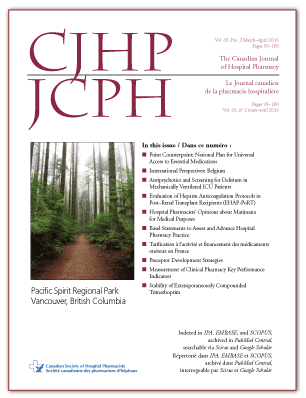Antipsychotic Drug Use and Screening for Delirium in Mechanically Ventilated Patients in Canadian Intensive Care Units: An Observational Study
DOI:
https://doi.org/10.4212/cjhp.v69i2.1537Keywords:
antipsychotic, delirium, screening, mechanical ventilation, intensive care, antipsychotique, délire, dépistage, ventilation mécanique, soins intensifsAbstract
ABSTRACT
Background: Critically ill patients frequently experience delirium, and antipsychotic drugs are often used to manage symptoms.
Objectives: To describe the use of antipsychotic drugs and delirium screening tools in mechanically ventilated, critically ill adult patients in Canadian intensive care units (ICUs) and to identify factors associated with the use of antipsychotic drugs.
Methods: Pharmacists from 51 Canadian ICUs prospectively collected data on antipsychotic use and delirium screening in all patients for whom invasive mechanical ventilation was initiated during a chosen 2-week period occurring sometime in 2008 or 2009.
Results: Data were collected for a total of 712 patients, of whom 115 (16.2%) received at least one dose of an antipsychotic. The antipsychotic prescribed, the total daily dose, and the administration schedule varied across sites. Delirium screening tools, validated for use in mechanically ventilated patients and endorsed by professional society guidelines, were part of routine care in a minority of ICUs (7/51 [13.7%]), and delirium screening was documented for few patients overall (41/712 patients [5.8%]). In a multivariable analysis, administration of antipsychotics was independently associated with longer duration of mechanical ventilation (odds ratio [OR] 1.12, 95% confidence interval [CI] 1.07–1.17), daily interruption of sedation (OR 1.71, 95% CI 1.01–2.90), and use of physical restraints (OR 2.15, 95% CI 1.27–3.65).
Conclusion: A minority of mechanically ventilated patients in Canadian ICUs received antipsychotic drugs, and screening for delirium with validated tools was rare. Antipsychotic drug use was independently associated with longer duration of mechanical ventilation, daily interruption of sedation, and use of physical restraints.
RÉSUMÉ
Contexte : Les patients gravement malades souffrent fréquemment de délire, une affection dont les symptômes sont souvent traités à l’aide d’antipsychotiques.
Objectifs : Dresser le portrait de l’utilisation des antipsychotiques et des outils de dépistage du délire chez les patients adultes gravement malades sous ventilation mécanique ayant séjourné dans une unité de soins intensifs (USI) canadienne et relever les facteurs associés à l’utilisation des antipsychotiques.
Méthodes : Des pharmaciens de 51 USI canadiennes ont recueilli des données de façon prospective sur l’utilisation des antipsychotiques et sur le dépistage de cas de délire auprès de tous les patients placés sous ventilation mécanique effractive au cours d’une période de deux semaines entre 2008 et 2009.
Résultats : Les données ont été recueillies chez un total de 712 patients. De ce nombre, 115 (16,2 %) ont reçu au moins une dose d’un antipsychotique. L’antipsychotique prescrit, la posologie quotidienne et l’horaire d’administration variaient d’un établissement à l’autre. Des outils de dépistage du délire (dont l’emploi est validé chez les patients sous ventilation mécanique et approuvé dans les lignes directrices d’associations professionnelles) ne faisaient partie des soins habituels que dans un petit nombre d’USI (7/51 [13,7 %]). De plus, les dépistages du délire n’ont été consignés que pour peu de patients dans l’ensemble (41/712 patients [5,8 %]). Au cours d’une analyse multivariable, on a associé indépendamment l’administration d’antipsychotiques à une durée accrue de la ventilation mécanique (risque relatif approché [RRA] de 1,12, intervalle de confiance [IC] à 95 % de 1,07–1,17), à une interruption quotidienne de la sédation (RRA de 1,71, IC à 95 % de 1,01–2,90) et à l’emploi de contention physique (RRA de 2,15, IC à 95 % de 1,27–3,65).
Conclusions : Seul un petit nombre de patients sous ventilation mécanique ayant séjourné dans une USI canadienne ont reçu des antipsychotiques; de plus, des outils validés de dépistage du délire n’ont que rarement été employés. L’utilisation d’antipsychotiques a été indépendamment associée à une durée accrue de la ventilation mécanique, à l’interruption quotidienne de la sédation et à l’emploi de contention physique.
Downloads
Published
Issue
Section
License
Copyright © Canadian Society of Healthcare-Systems Pharmacy.
After publication of a manuscript in the CJHP, the authors of the manuscript must obtain written permission from the CSHP (publications@cshp.ca) before reproducing any text, figures, tables, or illustrations from the work in future works of their own. If a submitted manuscript is declined for publication in the CJHP, all said rights shall revert to the authors. Please note that any forms (e.g., preprinted orders and patient intake forms) used by a specific hospital or other health care facility and included as illustrative material with a manuscript are exempt from this copyright transfer. The CJHP will require a letter from the hospital or health care facility granting permission to publish the document(s).










